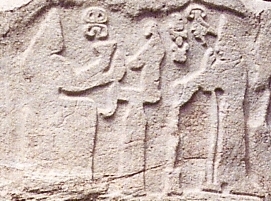Puduḫepa facts for kids
Quick facts for kids Puduḫepa |
|
|---|---|
| Queen of the Hittites | |

The figure on the right is Queen Puduḫepa
|
|
| Spouse | King Hattusili III |
| Issue | Tudhaliya IV Maathorneferure Kiluš-Ḫepa |
| Father | Bentepsharri |
Puduḫepa was a powerful Hittite queen who lived in the 13th century BC. She was married to King Hattusili III. Many people consider her one of the most important women from the Ancient Near East.
Contents
Puduḫepa's Life and Reign
Early Life and Marriage to Hattusili III
Puduḫepa was born around the early 1200s BC. Her hometown was Lawazantiya in a region called Kizzuwatna, which is now part of Turkey. Her father, Bentepsharri, was a very important priest for the city's main goddess, Ishtar. Puduḫepa also became a priestess for this goddess.
After a big battle called the Battle of Kadesh, a Hittite general named Hattusili met Puduḫepa. It is said that the goddess Ishtar told him to find love and friendship with her. Puduḫepa then went with him to his kingdom.
Even though Hattusili was likely older than her, Puduḫepa became his most important wife. Later, Hattusili became the King of the Hittites after a civil war. When he became king, Puduḫepa became the tawananna, which means queen.
Puduḫepa's Role as Queen
Puduḫepa had a very important role in the Hittite court and in how the kingdom dealt with other countries. She was often seen with her husband, the king, when he made important choices. It seemed like she ruled alongside him, not just as someone who followed his orders.
Puduḫepa even had her own special seal, like a royal stamp. She was in charge of how the royal palaces were run. She also helped decide court cases. She even helped organize the many Hittite gods and goddesses.
From the capital city of Hattusa, Queen Puduḫepa used her children to help the Hittite kingdom grow stronger. She also used them to make alliances with other countries. No Hittite queen had ever done this before.
She was very important in dealing with Ancient Egypt. Many letters with Puduḫepa's seal still exist. These letters show her talking with Ramesses II, the king of Egypt. She helped make a peace treaty between the Hittites and Egypt. As part of this treaty, two of her daughters went to Egypt to marry Ramesses.
Puduḫepa also helped arrange a marriage for one of her daughters with King Kadashman-Enlil II of Babylonia.
Once, the king of Egypt, Ramesses II, said that Babylon was not important. Puduḫepa wrote back in a letter, "If you say 'The king of Babylon is not a Great King,' then you do not know the status of Babylon." This shows how smart and strong she was.
After her husband, Hattusili, died, Puduḫepa's role became even bigger. Her son, Tudhaliya IV, became king. She was known as the goddess-queen or queen mother. She was involved in legal matters and even helped organize the Hittite religion.
Her daughters included Queen Maathorneferure of Egypt and Princess Kiluš-Ḫepa.
Nefertari and Puduḫepa: A Royal Friendship
Queen Nefertari of Egypt, who was the wife of Ramesses II, sent special gifts to Puduḫepa. Here is part of a letter she sent:
The great Queen Naptera (Nefertari) of the land of Egypt speaks thus: ʻSpeak to my sister Puduḫepa, the Great Queen of the Hatti land. I, your sister, be well!! May your country be well. Now, I have learned that you, my sister, have written to me asking after my health. You have written to me because of the good friendship and brotherly relationship between your brother, the king of Egypt, The Great and the Storm God will bring about peace, and he will make the brotherly relationship between the Egyptian king, the Great King, and his brother, the Hatti King, the Great King, last for ever... See, I have sent you a gift, in order to greet you, my sister... for your neck (a necklace) of pure gold, composed of 12 bands and weighing 88 shekels, coloured linen maklalu-material, for one royal dress for the king... A total of 12 linen garments.’
|
|||||||||||||||||||||||||||||||||||||||||||||||||||||||||||||||||||||||||||||||||||||||||||||||||||||||||||||||||||||||||||||||||||||||||||||||||||||||||||||||||||||||||||||||||||||||||||||||||||||||||||||||||||||||||||||||||||||||||||||||||||||||||||||||||||||||||||||||||||||||||||||||||||||||||||||||||||||||||||||||||||||||||||||||||||||||||||||||||||||||||||||||||||||||||||||||||||||||||||||||||||||||||||||||||||||||||||||||||||||||||||||||||||||||||||||||||||||||||||||||||||||||||||||||||||||||||||||||||||||||||||||||||||||||||||||||||||||||||||||||||||||||||||||||||||||||||||||||||||||||||||||||||||||||||||||||||||||||||||||||||||||||||||||||||||||||||||||||||||||||||||||||||||||||||||||||||||||||||||||||||||||||||||||||||||||||||||||||||||||||||||||||||||||||||||||||||||||||||||||||||||||||||||||||||||||||||||||||||||||||||||||||||||||||||||||||||||||||||||||||||||||||||||||||||||||||||||||||||||||||||||||||||||||||||||||||||||||||||||||||||||||||||||||
|
|||||||||||||||||||||||||||||||||||||||||||||||||||||||||||||||||||||||||||||||||||||||||||||||||||||||||||||||||||||||||||||||||||||||||||||||||||||||||||||||||||||||||||||||||||||||||||||||||||||||||||||||||||||||||||||||||||||||||||||||||||||||||||||||||||||||||||||||||||||||||||||||||||||||||||||||||||||||||||||||||||||||||||||||||||||||||||||||||||||||||||||||||||||||||||||||||||||||||||||||||||||||||||||||||||||||||||||||||||||||||||||||||||||||||||||||||||||||||||||||||||||||||||||||||||||||||||||||||||||||||||||||||||||||||||||||||||||||||||||||||||||||||||||||||||||||||||||||||||||||||||||||||||||||||||||||||||||||||||||||||||||||||||||||||||||||||||||||||||||||||||||||||||||||||||||||||||||||||||||||||||||||||||||||||||||||||||||||||||||||||||||||||||||||||||||||||||||||||||||||||||||||||||||||||||||||||||||||||||||||||||||||||||||||||||||||||||||||||||||||||||||||||||||||||||||||||||||||||||||||||||||||||||||||||||||||||||||||||||||||||||||||||||||
References:
|
|||||||||||||||||||||||||||||||||||||||||||||||||||||||||||||||||||||||||||||||||||||||||||||||||||||||||||||||||||||||||||||||||||||||||||||||||||||||||||||||||||||||||||||||||||||||||||||||||||||||||||||||||||||||||||||||||||||||||||||||||||||||||||||||||||||||||||||||||||||||||||||||||||||||||||||||||||||||||||||||||||||||||||||||||||||||||||||||||||||||||||||||||||||||||||||||||||||||||||||||||||||||||||||||||||||||||||||||||||||||||||||||||||||||||||||||||||||||||||||||||||||||||||||||||||||||||||||||||||||||||||||||||||||||||||||||||||||||||||||||||||||||||||||||||||||||||||||||||||||||||||||||||||||||||||||||||||||||||||||||||||||||||||||||||||||||||||||||||||||||||||||||||||||||||||||||||||||||||||||||||||||||||||||||||||||||||||||||||||||||||||||||||||||||||||||||||||||||||||||||||||||||||||||||||||||||||||||||||||||||||||||||||||||||||||||||||||||||||||||||||||||||||||||||||||||||||||||||||||||||||||||||||||||||||||||||||||||||||||||||||||||||||||||
| Notes: | |||||||||||||||||||||||||||||||||||||||||||||||||||||||||||||||||||||||||||||||||||||||||||||||||||||||||||||||||||||||||||||||||||||||||||||||||||||||||||||||||||||||||||||||||||||||||||||||||||||||||||||||||||||||||||||||||||||||||||||||||||||||||||||||||||||||||||||||||||||||||||||||||||||||||||||||||||||||||||||||||||||||||||||||||||||||||||||||||||||||||||||||||||||||||||||||||||||||||||||||||||||||||||||||||||||||||||||||||||||||||||||||||||||||||||||||||||||||||||||||||||||||||||||||||||||||||||||||||||||||||||||||||||||||||||||||||||||||||||||||||||||||||||||||||||||||||||||||||||||||||||||||||||||||||||||||||||||||||||||||||||||||||||||||||||||||||||||||||||||||||||||||||||||||||||||||||||||||||||||||||||||||||||||||||||||||||||||||||||||||||||||||||||||||||||||||||||||||||||||||||||||||||||||||||||||||||||||||||||||||||||||||||||||||||||||||||||||||||||||||||||||||||||||||||||||||||||||||||||||||||||||||||||||||||||||||||||||||||||||||||||||||||||||
See also
 In Spanish: Puduhepa para niños
In Spanish: Puduhepa para niños


